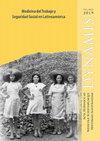Secvndvm Regvlam: Cuidados y asistencia a enfermos y ancianos en las reglas monásticas hispano-visigodas
IF 0.1
4区 哲学
Q3 HISTORY & PHILOSOPHY OF SCIENCE
引用次数: 1
Abstract
espanolLas reglas elaboradas para organizar la vida cotidiana en las comunidades monasticas que proliferaron en torno al Mediterraneo durante la Antiguedad Tardia son una privilegiada fuente de informacion para conocer cuales eran las circunstancias en las que vivian los enfermos y los ancianos durante ese periodo. El objetivo de este trabajo es utilizarlas para conocer mejor cual era la situacion de estos dos colectivos a finales de la Hispania tardoantigua. Las cuatro reglas monasticas conservadas se elaboraron en un arco cronologico que abarca desde la segunda mitad del siglo VI hasta un periodo similar del siglo VII, coincidiendo en gran medida con la duracion del reino hispano-visigodo de Toledo. Con su lectura se puede constatar la importancia de la asistencia social entre los cometidos habituales de los distintos monasterios que las tomaron por norma, ocupando un lugar fundamental los cuidados y las atenciones brindados a enfermos y ancianos. En todas ellas se muestra como se organizaban para cumplir tales cometidos y como se alteraban las normas de convivencia vigentes con la intencion de ofrecerles los cuidados oportunos. Se observa igualmente que tipo de alimentacion se consideraba util como medicina, como se debia tratar a los enfermos en lugares fisicamente separados del recinto monastico y quienes eran los mas aptos para ocuparse de ellos. Asimismo, se aprecia como tales cuidados no se dispensaban unicamente a los miembros de las comunidades, sino que se hacian extensivos a personas del exterior. Se documenta, ademas, como en la zona noroccidental se habia extendido la practica de que los ancianos ingresaran en los monasterios llevados sobre todo por las emergencias propias de una edad avanzada. EnglishRules for the organization of daily life in the monastic communities that proliferated around the Mediterranean during Late Antiquity are a privileged source of information on the life circumstances of sick and elderly people during this period. The objective of this study was to use this information to determine the situation of these two populations at the end of Late Antique Hispania. The four monastic rules preserved were formulated during a chronological period extending from the second half of the 6th century to the second half of the 7th century, largely coinciding with the duration of the Hispanic-Visigoth Kingdom of Toledo. They reveal the importance of social welfare among the habitual duties of the different monasteries, which adopted them as rules. In this way, these monasteries became vital places for the care of the sick and elderly. The rules show how they were organized to carry out these duties and how restrictions on cohabitation could be modified to enable the delivery of appropriate care. They also reveal the type of food considered medicinally useful, the requirement to treat the sick in places physically separated from the monastic area, and the most appropriate people to provide care. The rules also establish that this care was offered not only to members of their community but also to outsiders. The practice of admitting elderly people into monasteries became extensive in the North-West area, largely for the health emergencies that characterize old age.Secvndvm Regvlam:西班牙-西哥特修道院规则中对病人和老人的照顾和援助
在古代晚期,在地中海周围激增的修道院社区中,为组织日常生活而制定的规则是了解那个时期病人和老人生活环境的特权信息来源。在这一时期,西班牙裔和拉丁美洲人之间的关系发生了重大变化,在这一时期,西班牙裔和拉丁美洲人之间的关系发生了重大变化。现存的四项修道院规则是按照从6世纪下半叶到7世纪类似时期的时间顺序制定的,与西班牙-西哥特托莱多王国的持续时间大致一致。在这本书中,你可以看到社会援助在不同修道院的日常任务中的重要性,这些修道院将社会援助作为一种规范,对病人和老人的照顾占据了一个基本的位置。在这篇文章中,我们展示了他们是如何组织起来完成这些任务的,以及他们如何改变现有的共存规则,以便为他们提供适当的照顾。人们还注意到,什么样的食物被认为是有用的药物,病人应该如何在与修道院隔离的地方治疗,以及谁最适合照顾他们。它还表明,这种照顾不仅提供给社区成员,而且扩大到外部人士。它还记录了在西北地区,老年人进入修道院的做法是如何普遍存在的,主要是由于老年人的紧急情况。古代晚期地中海周围涌现的修道院社区日常生活组织的英文规则是关于这一时期病人和老年人生活环境的重要信息来源。对民间of this study was to use this information to The状况确定这些two人口at The end of Antique西班牙跳动。The four monastic rules preserved是formulated during a》period帮助from The second half of The期century to The second half of The, century, largely coinciding with The duration of The Hispanic-Visigoth王国托莱多。他们揭示了社会福利的重要性,在不同修道院的习惯职责中,他们采用的规则。在这种情况下,这些修道院是照顾病人和老人的重要场所。这些规则说明如何组织它们履行这些义务,以及如何修改对同居的限制,以便提供适当的护理。它们还揭示了被认为在医学上有用的食物类型,在与修道院地区物理分离的地方治疗病人的需要,以及提供护理的最合适的人。这些规则还规定,这种照顾不仅提供给社区成员,也提供给局外人。在西北地区,接纳老年人入院的做法越来越普遍,主要是由于老年人特有的健康紧急情况。
本文章由计算机程序翻译,如有差异,请以英文原文为准。
求助全文
约1分钟内获得全文
求助全文
来源期刊

Dynamis
社会科学-科学史与科学哲学
CiteScore
0.30
自引率
0.00%
发文量
0
审稿时长
>12 weeks
期刊介绍:
DYNAMIS is an international journal devoted to the history of medicine, health and science, founded in 1981, that pays special attention to novel and interdisciplinary historiographic perspectives. It offers original, double peer-reviewed research studies (articles, notes or documents) and reviews in languages of the European Union.
 求助内容:
求助内容: 应助结果提醒方式:
应助结果提醒方式:


